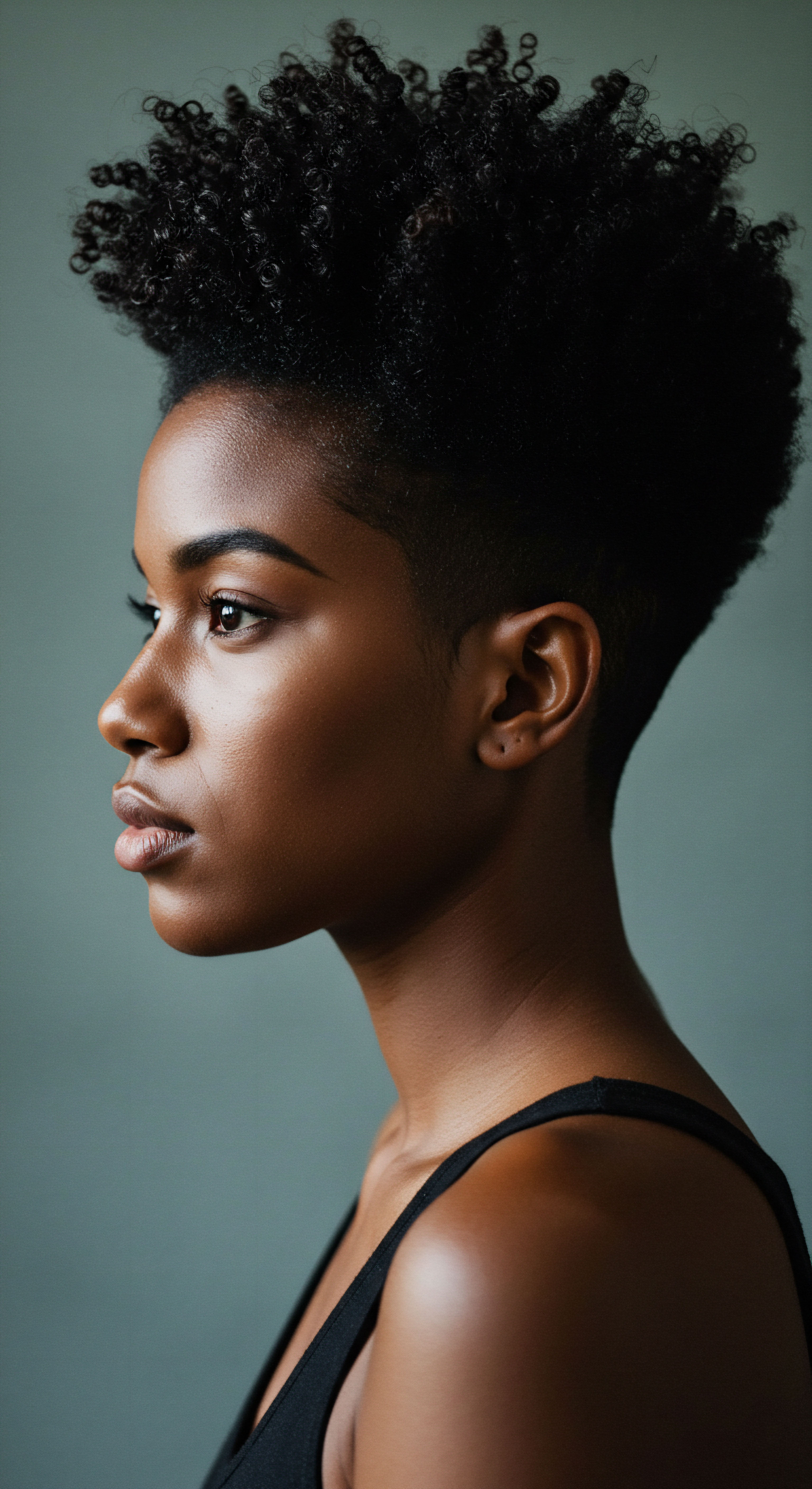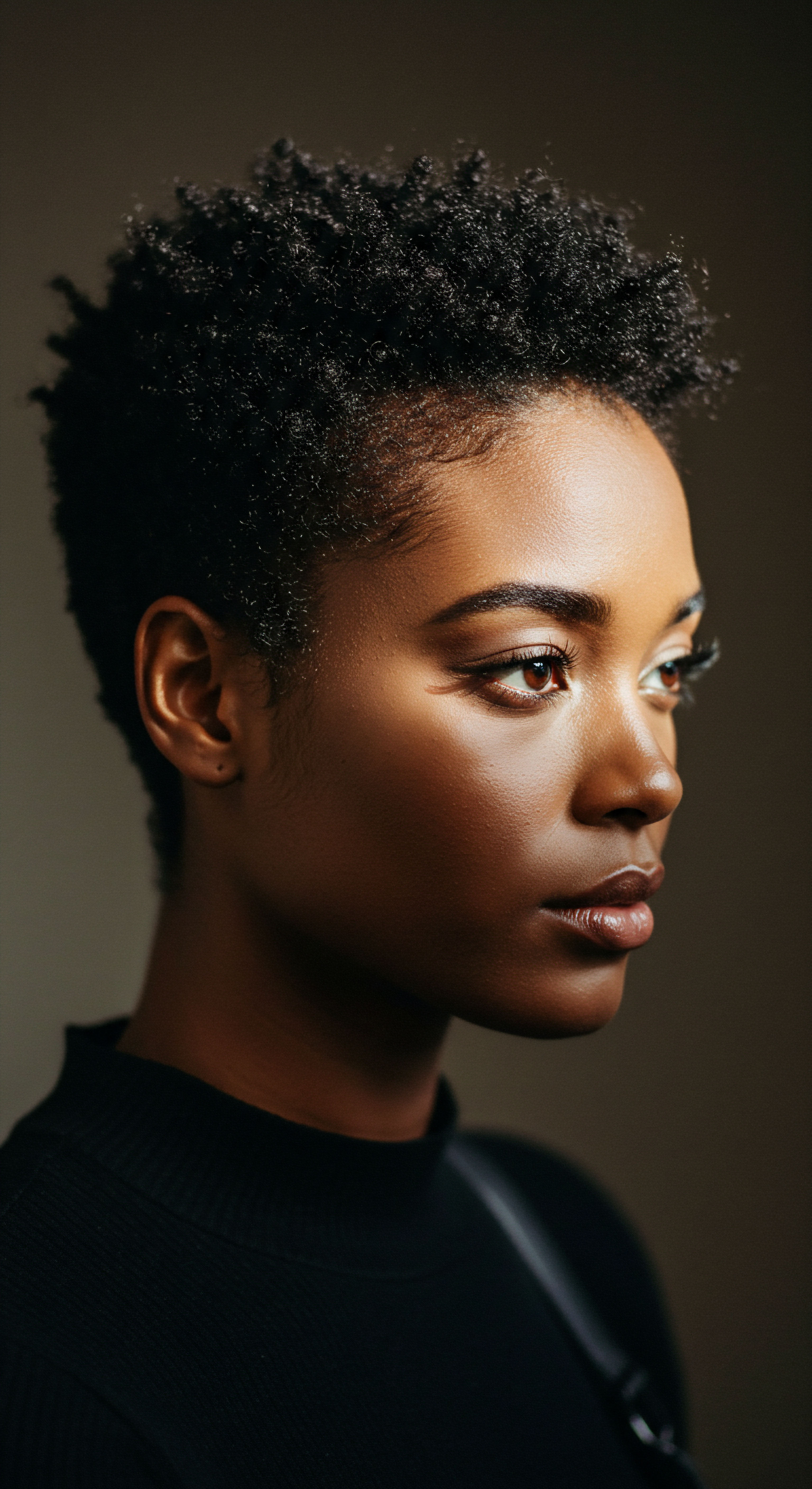
Fundamentals
Imagine your beloved strands, each a delicate filament spun from nature’s artistry, constantly encountering unseen elements within the very water used for cleansing. For those with textured hair, a unique conversation unfolds with their environment, one often shaped by the subtle yet persistent presence of minerals. Chelating treatments, in their simplest expression, represent a gentle hand reaching out to these strands, seeking to lift away what does not truly belong. They offer a moment of reprieve, a quiet clearing of the canvas so that hair’s inherent splendor can truly shine.
At its core, a chelating treatment is a specialized cleansing ritual designed to address mineral accumulation on hair. This accumulation often arises from what is commonly known as “hard water,” water rich in dissolved minerals such as calcium and magnesium. These minerals, though harmless in drinking water, can cling to hair fibers, particularly those with the intricate patterns of coils and curls.
Over time, this clinging forms an invisible film, diminishing hair’s natural vitality. The fundamental purpose of chelation, then, becomes a delicate unburdening, a thoughtful release of these mineral attachments.
Consider the daily wash. When hard water greets textured hair, its mineral passengers can settle onto the cuticle, the outermost layer of each hair shaft. For hair types celebrated for their diverse and often porous structures, this adherence can be particularly tenacious. The consequences manifest as a dulling of vibrancy, a resistance to moisture, and even a subtle alteration in how the hair feels to the touch.
The meaning of chelating treatments, therefore, extends beyond mere cleansing; it signifies a restoration of hair’s natural receptivity, allowing conditioning agents and hydrators to perform their intended work without obstruction. It’s a foundational step in preserving the delicate balance that textured hair requires for its well-being.
Chelating treatments delicately clear mineral accumulation from hair, particularly beneficial for textured strands.
The significance of this process for textured hair, especially within Black and mixed-race hair experiences, cannot be overstated. Our hair often possesses a unique architectural design, characterized by its varying porosity and tendency towards dryness. Hard water minerals exacerbate these natural inclinations, creating a cycle of diminished moisture and increased fragility. A chelating treatment, in this light, acts as a thoughtful intervention, interrupting this cycle by removing the mineral barrier.
This action allows the hair to truly absorb the nourishment it so deeply desires, paving the way for improved elasticity and a more supple feel. It is a purposeful act of care, acknowledging the specific needs of hair that has historically navigated unique environmental challenges.

Common Mineral Culprits
Several mineral types are frequently encountered in hard water, each contributing to the unwelcome film on hair. Understanding these elements deepens our comprehension of why chelating is so vital.
- Calcium ❉ A prevalent mineral in hard water, calcium deposits often lead to a stiff, rough texture, making hair feel less pliable.
- Magnesium ❉ Similar to calcium, magnesium contributes to dullness and can make detangling more challenging, leaving hair feeling coated.
- Iron ❉ Found in some water sources, iron can impart a reddish or orange tint to lighter hair colors and contribute to a metallic feel in darker shades.
- Copper ❉ Often introduced through old plumbing, copper can react with hair color, sometimes causing unwanted green tones, especially in blonde or chemically treated hair.

Intermediate
Moving beyond the foundational understanding, chelating treatments represent a practical solution within the comprehensive care regimen for textured hair. Their application transcends a simple wash; they embody a strategic approach to maintaining the vitality and responsiveness of curls, coils, and waves. This intermediate perspective explores how these treatments integrate into a thoughtful hair care practice, offering more than just cleanliness, but a pathway to sustained hair health and manageability. The meaning of chelating treatments, from this vantage, is about proactive intervention and the preservation of hair’s intrinsic qualities.
For individuals with textured hair, the impact of mineral accumulation extends beyond mere aesthetic concerns. The physical sensation of hair becoming resistant to styling, losing its natural bounce, or feeling perpetually dry despite consistent conditioning often signals the presence of these unwelcome mineral guests. Chelating treatments are designed to dismantle these mineral bonds, allowing the hair’s true texture to resurface. This process involves specific agents that act like microscopic magnets, drawing out and encasing the mineral ions so they can be thoroughly rinsed away.
Chelating treatments restore hair’s receptivity by dislodging mineral bonds, unveiling its true texture.
The practical application of chelating agents often appears in the form of specialized shampoos or dedicated pre-shampoo treatments. Unlike standard clarifying shampoos that primarily address product residue and surface oils, chelating formulations are specifically engineered to target and neutralize mineral deposits. This distinction is paramount for textured hair, which can be particularly susceptible to the drying and stiffening effects of hard water. By systematically removing these deposits, chelating treatments prepare the hair to better receive subsequent conditioning and styling products, optimizing their performance.

Identifying the Need for Chelation
Recognizing the signs of mineral buildup is the initial step toward incorporating chelating treatments effectively. These indicators are often subtle yet persistent, speaking volumes about the hair’s silent struggle.
- Dull Appearance ❉ Hair may lack its customary luster, appearing flat or lifeless even after fresh styling.
- Rough Texture ❉ Strands might feel coarse or straw-like, resisting softness despite regular moisturizing.
- Difficulty Lathering ❉ Shampoos might struggle to form a rich lather, a direct consequence of hard water minerals interfering with cleansing agents.
- Product Resistance ❉ Conditioners and styling products may seem less effective, failing to provide their usual hydration or hold.
- Unwanted Color Shifts ❉ Chemically treated hair, particularly lighter shades, might exhibit brassiness or an undesirable green tint.
A fascinating aspect of chelating treatments lies in their ability to indirectly enhance the efficacy of other hair care products. When hair is burdened by mineral deposits, it acts as a barrier, preventing deep conditioners, leave-ins, and even natural oils from truly penetrating the hair shaft. Once these mineral obstructions are gently lifted, the hair’s cuticle can lay smoother, allowing for superior absorption of beneficial ingredients. This means that cherished moisturizers can finally impart their full hydrating benefits, and styling products can achieve their desired hold and definition, leading to more consistent and satisfying results for textured hair.

Chelating Vs. Clarifying ❉ A Distinction
While both serve to cleanse deeply, a fundamental distinction exists between chelating and clarifying.
| Feature Primary Target |
| Chelating Treatment Mineral deposits (calcium, magnesium, iron, copper) |
| Clarifying Shampoo Product buildup, excess oil, environmental residue |
| Feature Mechanism |
| Chelating Treatment Binds to metal ions, allowing them to be rinsed away |
| Clarifying Shampoo Stronger surfactants to dissolve and wash away surface accumulation |
| Feature Frequency of Use |
| Chelating Treatment Less frequent, typically monthly or bi-monthly, depending on water hardness |
| Clarifying Shampoo More frequent, weekly or bi-weekly, depending on product use |
| Feature Resulting Feel |
| Chelating Treatment Hair feels lighter, softer, more receptive to moisture |
| Clarifying Shampoo Hair feels "squeaky clean," sometimes stripped if overused |
| Feature Understanding these differences guides optimal product selection for hair health. |
For textured hair, which often requires a delicate balance of cleansing without stripping natural oils, choosing a chelating treatment when mineral buildup is suspected offers a more targeted approach than simply relying on a harsh clarifying shampoo. This thoughtful selection protects the hair’s delicate moisture equilibrium while still effectively addressing the root cause of dullness and resistance.

Advanced
At an advanced echelon of hair science and care, the explication of chelating treatments transcends their surface-level utility, delving into the profound chemical and physiological interplay they orchestrate within the hair fiber, particularly within the unique architecture of textured, Black, and mixed-race hair. Here, the meaning of chelating treatments is not merely about removal, but a sophisticated intervention influencing the very structural integrity, porosity, and long-term health of these distinct hair types. This domain of understanding necessitates a deep appreciation for the molecular mechanics at play, alongside a culturally attuned awareness of hair’s historical and contemporary experiences.
A chelating agent, at its core, is a compound possessing multiple electron-donating atoms that can form stable, soluble complexes with metal ions. This chemical phenomenon, known as chelation (from the Greek word “chele,” meaning claw), effectively sequesters undesirable metallic contaminants, rendering them inert and easily rinsed from the hair shaft. Common agents include various forms of EDTA (Ethylenediaminetetraacetic Acid), Phytic Acid (inositol hexakisphosphate), Citric Acid, and Sodium Gluconate.
The efficacy of these agents hinges on their affinity for specific metal ions—calcium, magnesium, copper, and iron being the most prevalent culprits in hard water and environmental exposure. The higher the concentration of these chelants in a formulation, and the more strategic their molecular design, the greater their capacity to bind and remove these mineral adversaries from the hair’s surface and within its cortical layers.
The intricate structure of textured hair, characterized by its elliptical cross-section, numerous twists, and varying cuticle patterns, presents a distinct challenge to mineral deposition. These structural nuances create more surface area and potential entrapment sites for positively charged metal ions. When these ions adhere, they disrupt the hair’s natural anionic sites, interfering with moisture absorption and potentially altering the hair’s natural pH. This disruption is particularly critical for hair types already predisposed to dryness and fragility.
The presence of metal ions, especially copper, can also act as catalysts for oxidative damage, particularly when hair is exposed to chemical processes like coloring or relaxing. These ions facilitate the generation of reactive oxygen species, leading to protein degradation and a weakening of the hair’s disulfide bonds, which are crucial for its strength and elasticity.
Chelating agents, like molecular custodians, safeguard textured hair from mineral interference and oxidative damage.
The long-term implications of untreated mineral buildup on textured hair are considerable, extending beyond cosmetic concerns to impact hair health and even growth cycles. Persistent mineral coatings can stiffen the hair fiber, reducing its natural flexibility and increasing its susceptibility to breakage during styling or manipulation. This is especially true for hair that is frequently coiled, twisted, or braided, where flexibility is paramount. Furthermore, mineral deposits can clog follicular openings on the scalp, potentially impeding healthy hair growth and exacerbating scalp conditions such as dryness, flaking, or irritation.

A Deeper Dive into Chelating Agents
The selection and concentration of chelating agents within a product are critical to its performance.
- Ethylenediaminetetraacetic Acid (EDTA) and Its Salts (Disodium EDTA, Tetrasodium EDTA) ❉ These are among the most powerful and widely used synthetic chelating agents in hair care. Their multi-pronged structure allows them to form highly stable complexes with a broad spectrum of metal ions. While highly effective, their synthetic nature has led some consumers to seek alternatives.
- Phytic Acid (Sodium Phytate) ❉ A naturally derived compound found in plant seeds, phytic acid offers a bio-based alternative. It is an excellent chelator for various metal ions, including calcium, magnesium, and iron. Its presence in formulations can contribute to a more “natural” product profile, appealing to consumers prioritizing botanical ingredients.
- Citric Acid ❉ Commonly found in fruits, citric acid serves a dual purpose in hair care ❉ as a pH adjuster and a chelating agent. While less potent as a chelator than EDTA, it can still effectively bind to some metal ions, particularly in acidic conditions, which can also help smooth the hair cuticle.
- Sodium Gluconate ❉ Derived from glucose, this is another naturally occurring chelating agent. It is often favored for its gentler action and biodegradability, making it a popular choice for “cleaner” formulations.
From a cultural perspective, the persistent challenge of hard water in many urban centers, where a significant portion of the Black and mixed-race diaspora resides, underscores the historical and ongoing relevance of these treatments. Traditional African hair care practices, predating modern chemistry, often incorporated natural clays and plant-based ingredients known for their drawing and purifying properties, subtly performing a form of chelation through centuries of inherited wisdom. This historical continuity highlights a deep-seated communal understanding of the need to cleanse the hair of environmental and mineral impurities to maintain its strength and beauty.
Consider a study that illuminates the physical degradation caused by hard water on hair, particularly pertinent to hair structures that are inherently more delicate. Research published in the Journal of the Pakistan Medical Association found that exposure to hard water significantly reduced the Tensile Strength of hair. In a study involving 70 male participants, hair samples treated with hard water exhibited an average tensile strength of 238.49 N/mm², starkly lower than the 255.36 N/mm² observed in hair treated with de-ionized (soft) water. While this study did not specifically focus on textured hair, its findings underscore a critical physiological principle ❉ mineral deposition weakens the hair fiber, rendering it more vulnerable to breakage.
For textured hair, which naturally possesses fewer cuticle layers and can be more prone to mechanical stress due to its coiling patterns, this reduction in tensile strength translates to a heightened risk of damage and diminished length retention. The implication is clear ❉ regular and effective chelation is not merely a cosmetic choice but a structural imperative for preserving the resilience of textured strands against the pervasive influence of hard water.
The nuanced understanding of chelating treatments extends to their interaction with chemical services. For individuals with textured hair who choose to color, relax, or permanently wave their strands, the presence of metal ions can compromise the integrity and longevity of these processes. Copper, for instance, can react with peroxide in hair dyes, leading to uneven color results or accelerated fading. Iron deposits can cause chemical relaxers to work inconsistently, resulting in patchy straightening or increased damage.
A meticulous chelating process prior to such chemical alterations acts as a preparatory ritual, ensuring a cleaner, more uniform canvas. This practice allows chemical treatments to perform optimally, reducing the risk of undesirable outcomes and contributing to healthier hair post-service. The delineation of chelating treatments, therefore, is not complete without acknowledging their critical role in the complex chemistry of hair transformations.

The Physiological Impact of Mineral Buildup
The accumulation of minerals on hair is not a passive event; it triggers a cascade of physiological responses that can compromise hair health.
- Cuticle Disruption ❉ Mineral ions can wedge themselves between the hair’s cuticle scales, lifting them and leading to a rough, uneven surface. This impairs light reflection, causing dullness, and increases friction, making hair more prone to tangles and mechanical damage.
- Moisture Imbalance ❉ The mineral film creates a hydrophobic barrier, actively repelling water molecules. This prevents essential moisture from penetrating the hair shaft, leading to chronic dryness, brittleness, and a loss of suppleness, particularly detrimental to textured hair’s natural hydration needs.
- Oxidative Stress ❉ Certain metal ions, especially copper and iron, act as pro-oxidants. When exposed to oxygen and light, they catalyze the formation of free radicals. These highly reactive species attack hair proteins (keratin) and lipids, causing irreversible damage to the hair’s internal structure and contributing to premature aging of the fiber.
- Scalp Irritation ❉ Mineral deposits can accumulate on the scalp, disrupting its delicate microbiome and pH balance. This can lead to itching, flaking, and inflammation, potentially exacerbating conditions like eczema or psoriasis, and in some cases, indirectly affecting the hair follicle’s ability to produce healthy strands.
The strategic incorporation of chelating treatments into a textured hair regimen reflects an informed understanding of these multifaceted challenges. It represents a conscious decision to protect hair not only from external aggressors but also from the insidious, long-term effects of mineral interference. This deep comprehension moves beyond a superficial definition, positioning chelating treatments as a sophisticated, scientifically validated cornerstone of truly holistic textured hair care.

Reflection
As we draw our exploration of chelating treatments to a close, a quiet sense of profound understanding settles. It is a testament to the enduring spirit of hair care that from the simple act of cleansing, such intricate layers of science, history, and cultural resonance can unfold. For our textured strands, so often a canvas for identity and resilience, the journey of understanding chelating treatments has been one of revealing the unseen burdens and celebrating the liberation that follows.
The whispers of ancestral practices, the precise language of chemistry, and the heartfelt advocacy for hair wellness all converge in this singular topic. It reminds us that care for our crowns is not a fleeting trend, but a continuous dialogue with our environment, our heritage, and our inner wisdom. The subtle dance of minerals in water, the unique needs of a coil, the quiet strength found in knowledge—these are the threads that connect us, urging us to approach our hair with both scientific rigor and tender reverence.
Ultimately, chelating treatments serve as a gentle reminder that even the most seemingly mundane elements of our daily lives, like the water that graces our hair, hold the potential for either impediment or liberation. By understanding and embracing these specialized cleansing rituals, we not only restore our hair’s physical vibrancy but also honor its inherent capacity for beauty, allowing each strand to unfurl its true story, unburdened and truly free.

References
- Audrey Davis-Sivasothy. (2011). The Science of Black Hair ❉ A Comprehensive Guide to Textured Hair Care. Sivasothy Hair Company.
- Evans, K. et al. (2011). Hair Damage by Hard Water. International Journal of Cosmetic Science .
- Luqman, M. et al. (2018). Effect of Topical Application of Hard Water in Weakening of Hair in Men. Journal of the Pakistan Medical Association, 66(9), 1132-1136.
- Robbins, C. R. (2012). Chemical and Physical Behavior of Human Hair (5th ed.). Springer.
- Syed, A. (2016). Curly Hair Book ❉ Structure, Properties, & Care. As I Am.
- Warburton, J. (2015). Hair Structure and Chemistry Simplified. Milady.
- Zaid, N. A. M. & Khan, M. I. (2013). Effects of Hard Water on Hair. International Journal of Trichology, 5(2), 65-68.